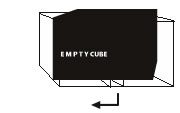ANA ANACLETO
MARCH, 31, 2010

CONTACTS
ana_anacleto@yahoo.com
EXHIBITION INFORMATION
THE MOST ACCURATE DISTANCE BETWEEN ME AND SOME OTHER
2010
video (two channels projection / DV, PAL(576i); 4:3, p&b, no sound, 180’)
two pairs: seeing vs. looking – remembering vs. reading
The piece entitled The most accurate distance between me and some other presents anachrony as a possible category for our understanding of its author’s thought structure and artistic process.
The video projection shows us a notebook, identified as such in the first picture shown, which corresponds to the instrument the artist often uses in her everyday life. This portable object, fit for the purposes of journeying and keeping intimate records, such as pictures, various notes or drawings, is a sign of a collecting approach that has the archive as its final destination. And that is what makes Ana Anacleto’s Moleskine notebook a near-simulacrum device, as if video editing had created a bridge between the notebook’s contents and anyone who had been given the possibility of leafing through it, in close connection with the data collected there.
It is as if we had been given access to her archive and to the way in which it is organised.
The use of double projection mimics the notebook format to replicate moving from page to page, via a succession of images or their absence. Thus the piece becomes disruptive, obliterating our expectations regarding the possibility of a narration, which had been suggested by the “index page” for the various pictures that opens the work. It is actually a false index, since it lacks chronological order, as well as information on the pages of the facsimiled notebook. All we are given is a list of the sets of collections that make up this archive, which I will now detail:
- "Artists on artists"
- "One act or two of curatorial staging"
- "Thinking metaphorically"
- "Heights and Widths"
- "Small visual essay on randomness"
- "Learning the world"
- "Angles, corners and borders"
The first series, “Artists on artists”, gives us a clue as to the systematisation of the piece via pairs of images or references, like for instance “Marcel on Marcel”, which in this case establishes a logic of correspondence between an artist and his object of reflection: the artist himself, or the work of another artist.
This same logic of correspondence slowly discloses, over the three hours of projection, how Ana Anacleto invites us to take in various levels of association, based on affinities acknowledged by the author herself, such as a staged relationship between artworks, where correspondence may occur between the title of one and the form of the other, which is evocative of a semantic connection. And there are also the architectural boundaries, visible in the depictions of corners, the implements for geometrical measurement, the maps she has kept and which no longer correspond to the current world, or her drawings, which form a non-hierarchical structure of pairings of objects that belong to a limited realm: her personal archives and collections.
This anachronistic process, with which we may contact only once, during a single non-stop, 180-minute screening, offers us an inquiry into memory as an imprecise correlate of images and references, as well as a new approach to the archive, as a diachronic map of events. It is as if the archive opened itself into a panoramic projection, allowing us to pick different points of entry, by establishing subjective, poetic, conceptual or formal rapports with it. It is the transformation of this archive/notebook device that activates its proximity with the spectator/reader, because the degree of importance each reproduction or form of thought holds in terms of the artist’s individual choice defines the degree in which we share her intimacy with the world. Thus, we find ourselves as close to it as a correspondent, or a reader.
João Silvério
March 2010





